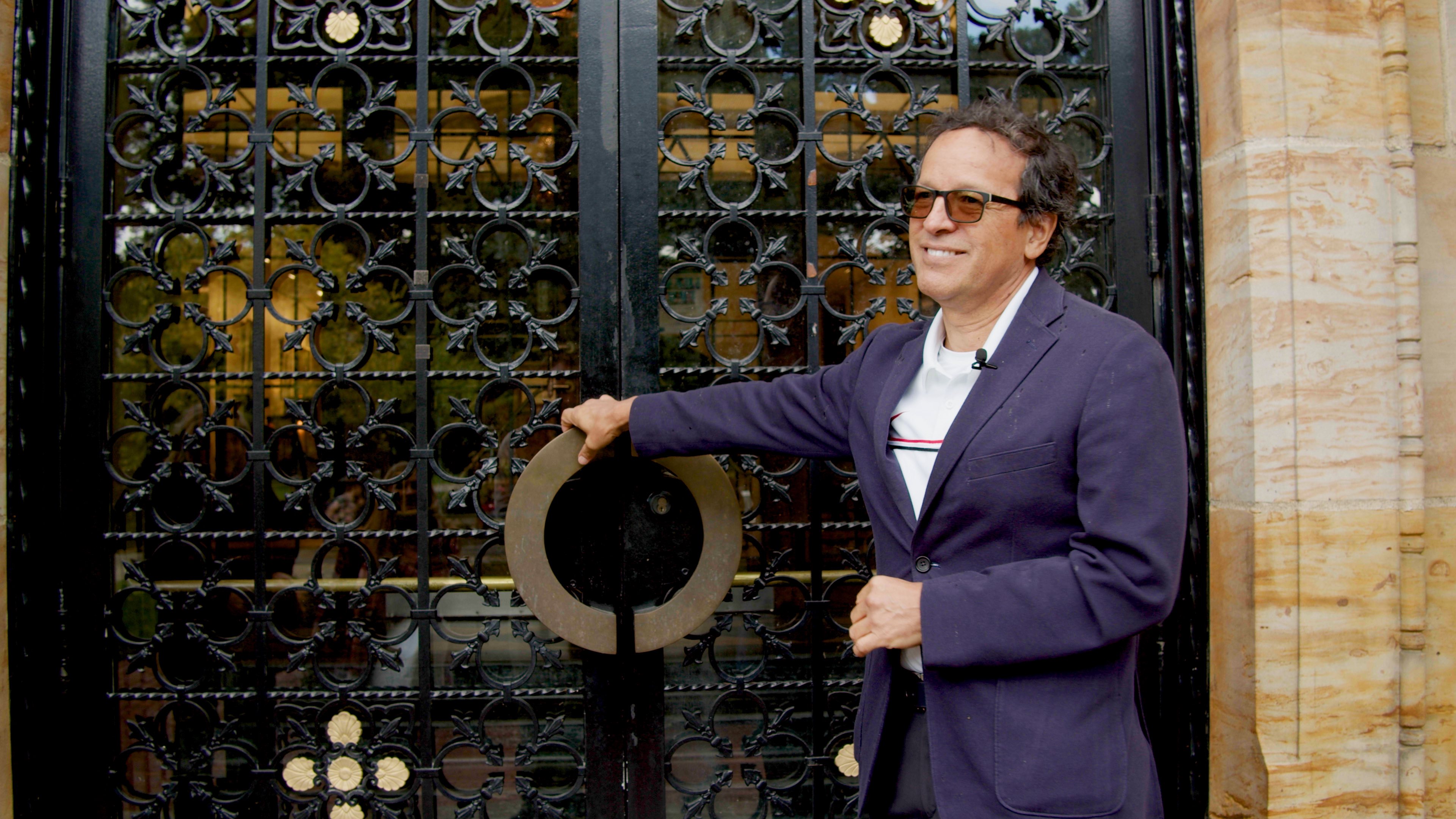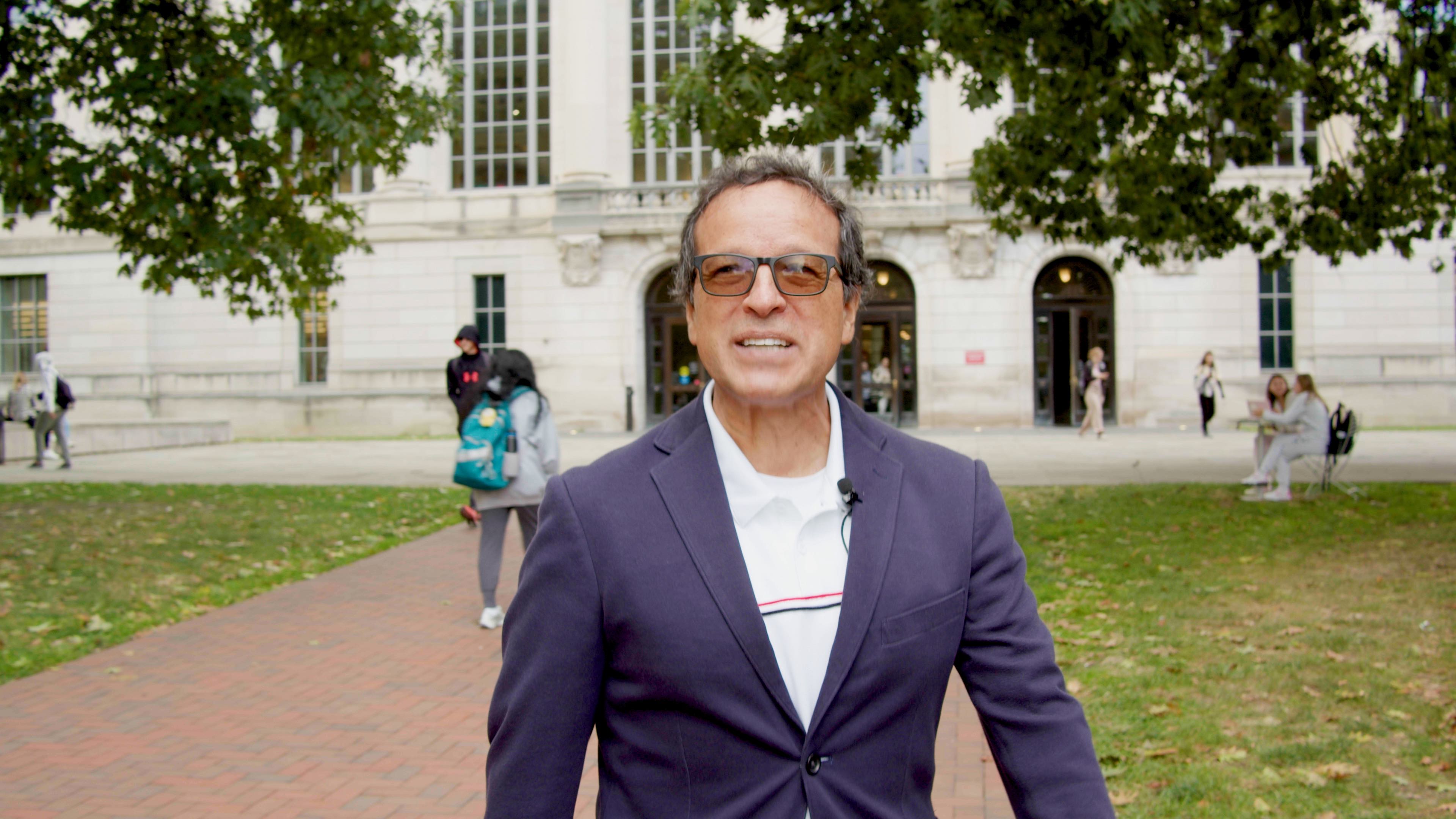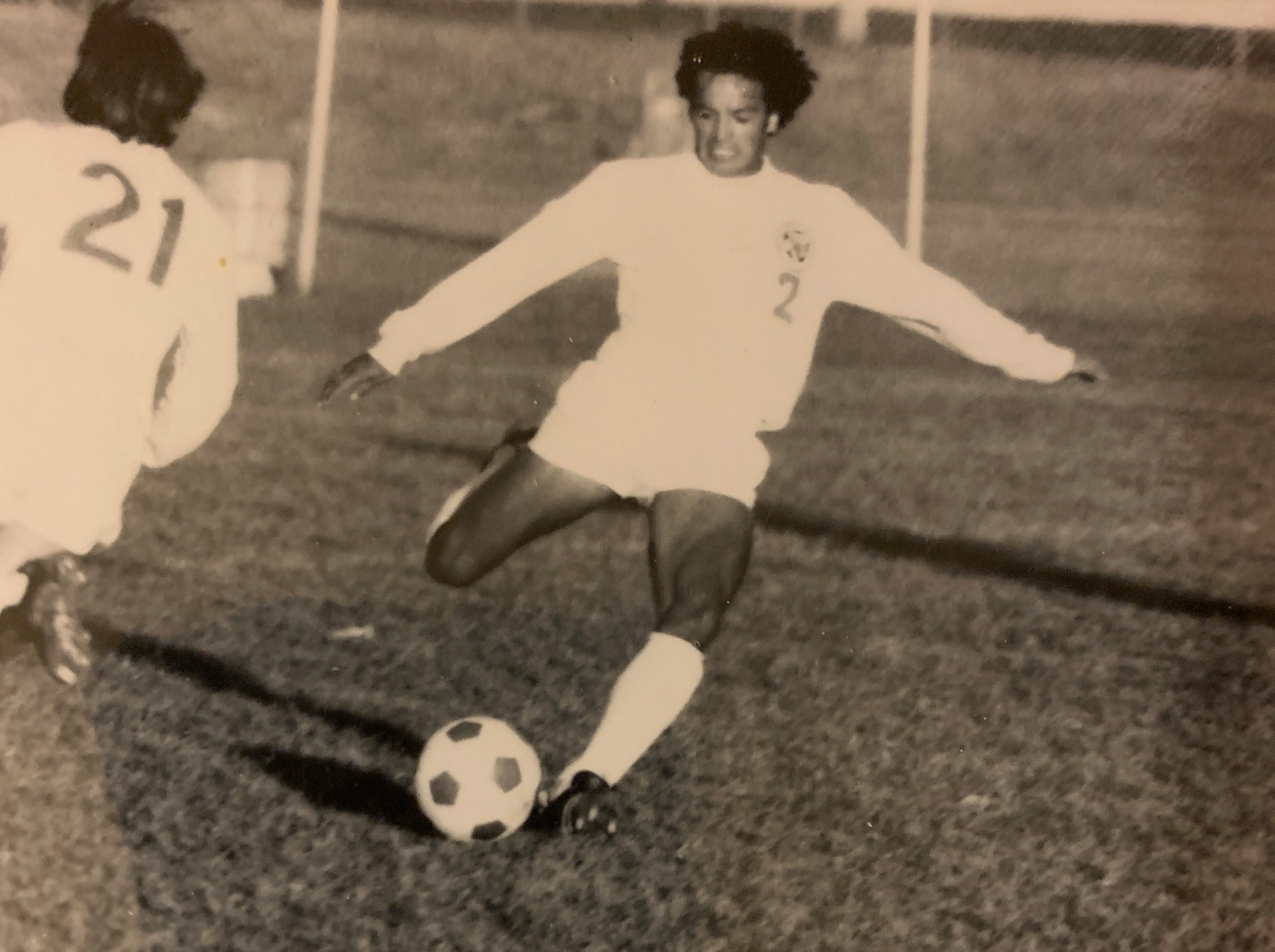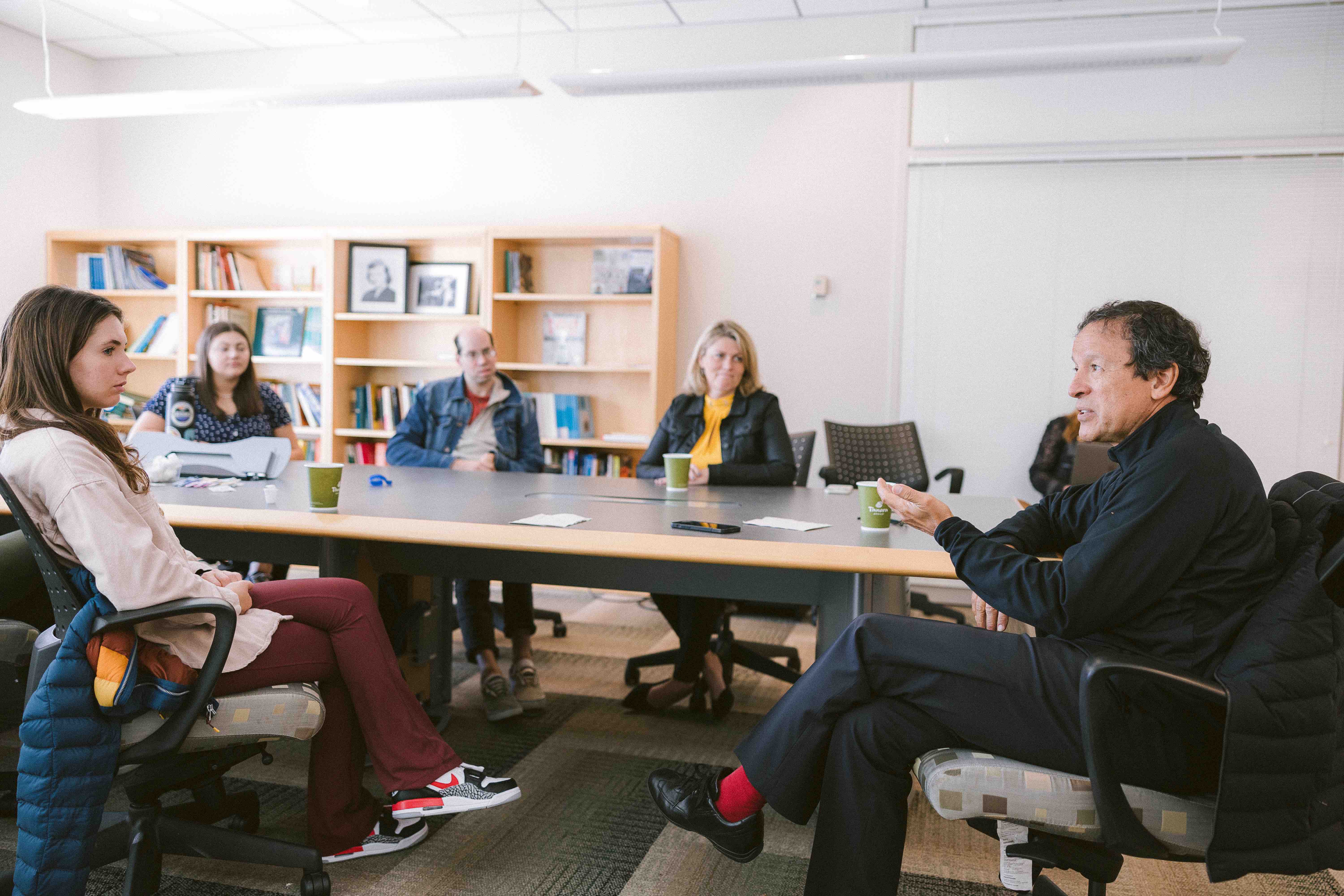
People love a story like Frank Vizcarra’s, because it makes them believe in possibilities. And Vizcarra, ’79 BS, really wants people to believe.
Long before he worked among the top brass at McDonald’s Corporation, before he was a professional soccer player and a two-time most valuable player for the Ohio State men’s soccer team, well before he earned a degree in physical education, Vizcarra was a boy living with four siblings and his mother in the poorest neighborhood of Tijuana, Mexico.
“We lived in a shack. My house was this big,” he said, motioning to half of the room where he now sat. “Dirt floor, no electricity, no running water.”
But those details are superfluous. You’ve heard stories like that before. What’s important is that someone — in truth, several someones — noticed the boy with smiling eyes, and saw something. Vizcarra recalls a traveling salesman carrying two stacks of shoe boxes tied together with twine. The man came to the barrio each Saturday, hawking black oxfords and loafers.

Pancho — his nickname means “free”— raced out of his house to get a look at the guy shouting, “Zapatos! Zapatos!” His single mom never could afford the shoes. But Pancho caught the salesman’s eye, and the man’s voice dropped to barely a whisper. “There’s something about you,” he would say, and then give Vizcarra a dime. Every Saturday, the same.
“‘There is something about you,’” Vizcarra whispers now as he remembers. “He could see something I couldn't. It was affirmation.”
Affirmation sees beyond circumstances and awakens a dream. These defining moments happened throughout Vizcarra’s life, he said, and he responded to the inspiration. Always at the right time, people came along to bolster him. Now he’s the one empowering others.
A look back at the steps of Thompson
When Vizcarra returned to Ohio State in September for a College of Education and Human Ecology alumni celebration, he had not seen the campus in decades. He stood in front of the limestone facade of Thompson Library and wept.
“I used to go through the door every single day and look for books to help me complete an assignment,” he said. “It was not unusual for me to be sitting at a table with probably 10 books right next to me. And I would read every single one of them.”

He was learning English still. His brain wrestled with the two languages as he tried to comprehend the finer details of human anatomy and physiology. He spent hours in the stacks.
“It was like a source of peace and quiet and learning and wisdom and hope. It was there for anybody to use,” he said.
“I lived here, and I loved it. I sometimes would go up to the fourth floor and just sit there and hide in one of the aisles all to myself and dream. Just dream. I would look out to the Oval ... just (wondering) what my life was going to be.”
He had already come so far but could scarcely imagine what was to come.
Hunger had changed him
Never far from Vizcarra’s thoughts are times when his future hung in the balance. Back in Tijuana, his mother made tortillas for $2 a day.
“If she worked, we ate. If she didn't work, we didn't eat. It was really that simple,” he said.
A neighbor might send him to the store to buy milk and tortillas, then give the food to his family. He sold eggs before school, knocking on doors of classmates who sometimes shut them in his face. He worked as a bagboy for a grocer after school.
When Vizcarra went to Mexico City for high school at 16, the grocer sent him $5 a month for food. He lived with 50 other students in one apartment, sleeping on the floor. If one month his mom or the grocer couldn’t send cash, he went hungry. But his will to learn was intense. Once, when he had not eaten for two days, he did something he hadn’t done before.
“I heard a voice in my mind that said, ‘Go beg,” he said. The directive was nothing less than Divine, he now says.
“So, I obeyed and walked two miles to the busiest street in Mexico City, called Insurgentes, and started begging. … Almost every person gave me money.”
The thought came to him that he should only ask for what he needed that day. He got sandwich money and stopped.
“I asked, ‘Why is this happening to me?’” Vizcarra recalls. “As I looked up into the heavens, I heard the voice say, ‘This is all part of your development. It is going to make sense someday.’ And now it does.”
Reaching for the American dream
Vizcarra immigrated to Eugene, Oregon, in 1973 with $5 in his pocket. He lived with his older brother and took every self-directed and community-based English course he could find, studying day and night.
“I immersed my entire life into the language,” he said. “When I crossed the border, I made a commitment to myself that I was starting a new world … that I needed to accept my new reality of being in a new country and to become the best American citizen that I could become. So, I committed, full in. And the first thing was, understand the language.”
He enrolled at a community college in Eugene, where he played soccer like a fiend, demolishing school records with 34 goals and 17 assists in one year. The stunned coach worked to get him a full scholarship to Ohio University, where Vizcarra enrolled. But Ohio State coach Bill Servidio had other ideas.
“(He) had been trying to recruit me for a year and a half. So eventually, he says, ‘Just come and visit. The team is getting better. We're going to take the team to Europe next year. We don't have scholarships, but we're supposed to get them.’”

The midfielder and his wife — by then he was married — made the leap and fell in love with Ohio State. They lived in off-campus housing and then in student family housing near Ackerman Road. Vizcarra bicycled to and from class. He crashed when he fell asleep while riding the bike after a late night studying on campus. Off-season, he conditioned by himself — running miles to the practice facility in 3 feet of snow.
Meanwhile, he switched majors to physical education. He became team captain, helped lead the Buckeyes to the most season wins in the history of the program to that point, and was named most valuable player his junior and senior years. He even caught the eye of a certain football coach.
“I had my left leg in the ice bucket … in a big tub,” Vizcarra said. “I could see Woody looking at me from a distance, from across the room. … Eventually he started coming towards me. And I was like, oh my God, here comes Woody! It was like, is he going to yell at me? Am I doing something wrong? Is he going to kick me out? You know, we shared the facilities (with) the football team.”
“And he comes over, right next to me, and says, ‘Hi, Frank. How are you doing?’ And I'm going, he knows my name!”
The coaching legend invited the soccer player to his office, asked how his academics were going, inquired whether he needed help and encouraged him to see his degree to completion.
Still poor, but well fed
Minus the scholarship, Vizcarra bused and waited tables of professors at the Faculty Club. The cooks quietly sent him home with prime rib after nearly every shift. Coach Jerry Bell found him odd jobs during breaks so that Vizcarra could buy his wife a Christmas present.
And the student athlete spent hours in the office and lab of Professor Donald Mathews, a pioneer in exercise physiology. “Famous guy, right? And, somehow, he liked me, and I loved him,” Vizcarra said.
Mathews invited him to participate in some of his clinical studies.
“And we became really, really close. … If I needed someone to talk to, he was always there. The attention that he gave me was way beyond just about his class or about what he was working on. It was also about me as a human, someone that he embraced, and probably felt sorry for. But at the same time, I was an athlete and I had something to provide to him.”
It was no surprise when the midfielder’s talent caught the eyes of recruiters. He was drafted by the Portland Timbers and Columbus Magic before graduating. Attending training camp meant finishing his senior winter semester in just seven weeks. He asked his professors for help.
“Every one of them said, ‘We'll help you, no problem. But let's talk,’” Vizcarra said. He would still need one semester to graduate.
“They were begging me to come back, encouraging me to come back. In my mind … it wasn't computing because there was nothing in my being that would stop me from coming back. But what got me was how much they cared about me, and how in the middle of 54,000 students, I was not lost,” he said.
‘Like a dog on a bone’
Vizcarra got his diploma at St. Johns Arena in autumn 1979. He played pro soccer for four years, in Columbus, Denver and San Diego. Always the go-getter, each day after practice he volunteered in the team’s front office, learning the nuts and bolts of sports administration.

“Plan A was, I will use the platform that the sport will give me to leverage that into a career in business,” he said. Plan B was to attend grad school to study sport management.
But he’d always had a yen for business — egg sales notwithstanding. It was a family thing. Back in Mexico, his mom moved the family out of their shack and into their first real house after selling American lard at a double markup. Years later, when he hung up his cleats, Vizcarra entered a career counseling program for retired athletes, the brainchild of baseball-great Steve Garvey. The program’s personality tests pointed Vizcarra to hospitality management. He never looked back.
He was 28 when he began his second career at the global restaurant chain Pizza Hut. He quickly put his team skills to work, and soon was heavily recruited by McDonald’s Corporation.
“They bumped (my salary) up 50%, and they gave me everything … even a company car,” he said.
“They put me on an executive fast-track program, where they put a bunch of people around me to teach me McDonald's at a fast pace. And within a short time, my salary almost doubled and then doubled again.”
When he excelled at one job, the company promoted him to another. He was their fix-it guy, and no problem was too tough. At one point, he held four different company titles at the same time.
“That persistence that I got from being here (at Ohio State), being committed to being a professional soccer player and then graduating from college — that persistence helped me through all of that. So, whenever a problem showed up, I would just go after it. And I wouldn't let it go until it was solved.”
“I was like a dog on a bone,” he said.
When the company was struggling after years of stagnant sales, Vizcarra, the company president and a cadre of colleagues led the charge in 2002 to restructure it.
“Everybody wanted to stay with the status quo; a group of us believed that we could do better,” he said. They brought back original recipes, refurbished restaurants, created the dollar menu, promoted new offerings such as salads. They aligned every employee — from cleaning staff to executives — to the new structure. And it worked.
He became chief of strategy for global operations two years later, and restructured operations in Europe, Asia Pacific, the Middle East and Africa.
It’s his turn
Vizcarra retired in 2006 at 50, the pinnacle of his career.
“The ‘voice’ told me to leave and go start a college program for kids. That’s the only reason I left. There is no other reason,” he said.
His portfolio included considerable stock shares and options that continued to gain even through the 2009 recession. He wanted for nothing, but he never forgot the kid he had been on the gritty streets of Mexico City. A host of people had brought him to where he is.
And so, Vizcarra bought his mom a house, big enough for their enormous family to gather. (Ever the entrepreneur, the 85-year-old rents spare rooms to make extra cash.) Four years ago, Vizcarra named his new restaurant chain, LOLA 55, after her. The upscale taco eateries borrow from her Peruvian bean recipe.
He founded a program that mentors under-resourced students and helps fund their college, ending the poverty cycle for them. Plans are underway for similar scholarships at Ohio State.
He has for years mentored the next generation, still writes notes of encouragement to near strangers and calls people on weekends just to say he believes in them. His faith remains a force, as the “Voice” still speaks to him. He still listens.

“When I came here,” he said, “I never expected what I received, people that really care about me. They saw something that I didn't see, and they just kept encouraging me and pushing me and never giving up on me. Ever.”
“They never knew the impact that they had on me, as a human. To have someone, a group of people behind you, that care enough for a young immigrant kid. It was amazing. That's why I'm here today."
"It's my time now to do that,” he said.
As for that spark the shoe salesman and others saw, everyone has it, Vizcarra believes. “Sometimes they don't take the time to unlock it, because life is hard,” he said.
For them, a little affirmation at just the right time can go a very long way, he said. If Pancho believed in the possibilities, everyone can.
There is something about you.




